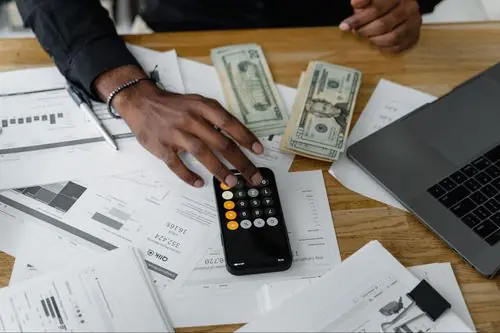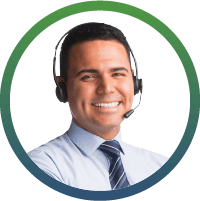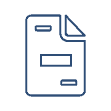Table of Contents
Understanding Overdrafts
When your bank account balance is negative, you may be feeling stressed and unsure of your next steps – but you are not alone. According to the Consumer Financial Protection Bureau, over 25% of consumers reported that at least one member of their household was charged an overdraft fee in the past year. But you might be asking yourself, “What can I do if my bank account is overdrawn and I have no money?”
While being in this situation can be incredibly overwhelming, you can learn how to navigate it and regain control of your money. The first step to taking back control of your finances is understanding overdraft fees and how they work. Overdraft fees occur when you do not have enough money in your account to cover a transaction. For example, if you write a check, use your debit card, or make an electronic payment for an amount that exceeds the amount you have in your bank account, you will overdraft your account if your bank covers the transaction on your behalf.
Overdrafting your account results in a negative bank balance, and you will likely be charged a fee if your bank covers the transaction for you. There are a few different kinds of overdraft fees, including the ones listed below:
Typical Overdraft Fees
Overdraft fees can vary from bank to bank, but overdraft fees are typically around $35 per transaction. In some cases, banks will charge daily overdraft fees and you will be charged a predetermined fee every day until your bank account is returned to a positive number.
Extended Overdraft Fees
If you allow your account balance to remain negative for several days, you may also be charged an extended overdraft fee. Some banks may refer to this fee as a sustained overdraft fee or an extended balance overdraft fee.
Now that you understand more about overdraft fees, keep reading to get more information about the actionable steps that you can take to fix your current financial situation. If you need emergency cash in a hurry because your bank account is overdrawn, don’t panic. Apply for a ChoiceCash title loan and use your loan proceeds to bring your balance back to a positive number! Visit our FAQ page or call 855-422-7402 today to learn more about this option.
Immediate Actions to Take When Your Bank Account Is Overdrawn and You Have No Money

If you don’t understand how to budget properly and you consistently do not keep track of your finances, you may end up overdrawing your bank account. This should not become a habit, and if you find yourself in a situation where your bank account is overdrawn and you have no money, you need to take the necessary steps to get your account balance positive again. In the long term, you should prioritize learning how to manage your finances.
Below are the following steps you should take if you find yourself with an overdrawn bank account:
- Assess Your Current Financial Situation
- Do NOT Use Your Overdrawn Bank Account
- Get Your Bank Balance Positive Again
- Contact Your Bank for Assistance
- Explore Options for Emergency Cash
The first thing that you should do is check your account balance and see how much your account is overdrawn so that you can plan the next steps to resolve the issue. Once you have a clear picture of the amount of money that you owe the bank – including any overdraft fees – you may begin to solve this problem. If your account is overdrawn, do not continue to use your overdrawn account. Instead, just try to focus on what you can control, and work towards getting your bank account out of the red as soon as possible.
If you can’t afford the overdraft fees, the next step is to contact your bank immediately. If there was a financial emergency or other extenuating circumstances that caused you to overdraft your account, you must communicate this issue with your bank as soon as possible. If you have never overdrawn your account before, your bank may decide to waive the overdraft fee. However, your bank is less likely to do this if you are a repeat offender, which is why it is so important to manage your finances!
If you are facing a financial emergency due to medical issues or another related issue, then the last step is to find ways to get extra cash to deal with your overdrawn bank account and solve your current situation. Additionally, if you find yourself consistently overdrawing your bank account, you may need to find a way to either cut down your monthly expenses or increase your income. Side hustles are a great way to earn extra income and help you stay on top of your finances! Reaching out to friends or family members for a loan is another option, but keep in mind that borrowing money from a loved one can negatively affect your relationship.
You can also see if you qualify for a ChoiceCash title loan if you have overdrawn your bank account and you have no money. Qualified borrowers are able to receive their funds as soon as the next business day! In some cases, you can get your funds the same day you are approved.1
Preventing Overdraft in the Future
If you’ve been in this situation more times than you can count, make sure you’re taking the proper steps to maintain your finances to avoid overdraft fees in the future. Not only does being in this situation impact your bank account, but the stress that accompanies poorly managed finances can adversely affect your mental health! The good news is that you can check out the following tips and tricks to get your finances back on the right track:
- Establish Low Balance Account Alerts and Notifications
- Link Your Accounts
- Set Up Automatic Payments
- Get Rid of Overdraft Protection
If you don’t have your bank account alerts turned on already, now is the time to start! Use your bank’s mobile app or website to set up account alerts and notifications so you can stay on top of your finances and move toward financial stability. Getting an alert if your bank account balance is low or overdrawn can help you take immediate action to resolve it, allowing you to properly monitor and manage your finances.
Keep in mind that if your account is overdrawn but you transfer money to your account by the end of that same business day, many banks will not charge an overdraft fee. You may have the option to link your savings account to your checking account so that funds can automatically transfer when your account is overdrawn.
Setting up automatic payments for your mortgage, rent, utility bills, title loans, and other recurring expenses can help you avoid missing payments and late fees. You can set up your paychecks to be directly deposited into your account, which can often ensure that you have money to handle your scheduled automatic payments. Pairing a solid budgeting plan with automatic payments can be a great match to stay on top of your finances. Start by analyzing your income and expenses, including your fixed and variable expenses. If you don’t want to use a physical budgeting spreadsheet, you can use online budgeting apps like Mint or Rocket Money to establish how much you are making each month and compare that to your current expenses. Creating a budgeting plan can help you better understand your spending habits and identify areas where you can cut back, which may lead to you staying out of the red more often.
The more you are able to cut back, the more you can save and potentially avoid overdrawing your account! You may want to get rid of overdraft protection so that your bank does not cover any payments on your behalf, which means that you will be essentially unable to overspend with your checking account.
Ultimately, learning how to manage your money and monitoring your spending habits are the keys to avoiding a negative bank account balance and overdraft fees. While it is impossible to predict emergency expenses, you can put yourself in a better position to succeed by saving as much money as possible.
How to Recover From an Overdrawn Account

If you have an overdrawn bank account and you don’t have any money, don’t panic! Take a moment to review the charges on your bank statement that caused your balance to become negative. It’s crucial to go over your bank statements on a regular basis to make sure there are no fraudulent charges on your account. If all of the charges are valid, then you need to take some time to speak with your bank representatives. Many banks are willing to work with customers facing financial difficulties, especially if their accounts are generally in good standing. In some cases, you may be able to negotiate with your bank to have your overdraft fee waived. Whether or not your bank will work with you to waive the fee, you need to come up with a plan to get your bank account out of the red as soon as possible!
If you are still a few days away from payday and your account is negative, the fact that you need extra money to get to a positive bank account balance should signal you to check if your budget is still on track. As soon as you have brought your bank account balance out of the negative, you should concentrate on controlling your spending habits and working towards financial stability. It takes time and effort to recover from an overdrawn bank account. However, if you stick to a realistic budget and make responsible choices, you will likely see positive changes over time!
Additionally, the importance of having an emergency fund cannot be overstated. Many financial experts agree that the best practice is to keep three to six months’ worth of expenses in an emergency fund in order to be prepared for anything life throws at you. While having a solid emergency fund can be useful for various reasons, some of the most beneficial ones are the following:
- Cover Unexpected Expenses Such as Home Repairs, Medical Bills, or Car Repairs
- Avoid Going Further Into Debt
- Provides More Financial Stability
- Can Be Used To Get Your Bank Account Out Of The Red
- Reduces Financial Stress
If you have been saving for quite a while and you have a sufficient emergency fund, you won’t need to rely on a title loan or your loved ones to save the day when your bank account is overdrawn and you have no money. Recovering from an overdrawn account involves setting your finances up for success in the future so that you can reach your long-term financial goals!
Get Professional Financial Advice
If you are in a position where you are constantly struggling with money, it may be time to search for professional financial advice. There are many benefits to receiving professional advice about managing your finances and spending habits, and you don’t have to be bad with money to speak to an advisor. Some of the major perks of seeking out a professional financial advisor can include:
Personalized Feedback and Financial Planning
Finances are not a “one-size-fits-all.” Every individual has a unique set of financial needs and goals, so not all of the financial advice that you can find online will work for you. When you work one-on-one with a financial advisor, they can help to give you advice that is tailored to your individual financial goals in order to help you be more successful with money.
Professional and Realistic Advice
One of the factors that makes financial advisors so important during tough situations is that they are professionals! Managing finances and a financial portfolio is a complex job with a lot of nuance because there are so many variables involved. Additionally, the financial world is an industry that is constantly changing. By seeking out professional financial advice, you are working with an individual who has studied finances, and budgeting, and has more experience than the average person.
Another huge advantage of working with a financial advisor is that they are an unbiased third party who can objectively review your finances, so it’s easier for them to help you find realistic financial goals.
More Accountability
Accountability is an important part of becoming financially stable, especially if you struggle to stick with a budget. When you put your goals down on paper or discuss your goals with another individual, you now have a person who is aware of them, so they can hold you accountable when necessary.
Consider a Title Loan When Your Bank Account Is Overdrawn and You Need Money
Do you need emergency cash to get a positive bank balance? With a title loan, your vehicle’s title is pledged as collateral for the loan, and your eligibility is primarily based on your car’s value and your income. You can access up to $15,000 through a ChoiceCash title loan serviced by LoanMart even if you have bad credit! If you qualify for a ChoiceCash title loan, you’ll be able to get a few different perks, including cash in as little as 24 hours, flexible loan terms, and competitive interest rates.1
If your bank account is negative and you do not have any money, you can apply for a title loan by filling out a short prequalification form or calling 855-422-7402 to speak with a friendly ChoiceCash loan agent. Don’t wait to see if you qualify for the financial assistance you need to get back on track with your bank account!





